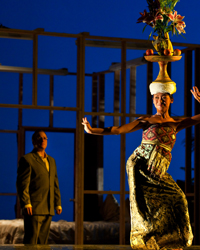
There’s been a vogue in recent years of opera composers attempting to blend western and eastern musical and performance styles in operas. One element which a lot of these operas have in common is a tension between achieving a perfect mix between vastly different cultural traditions while at the same time demonstrating how little they have in common. That the oil and water effect is ultimately the aspect of these operas that remains most powerfully in the memory after the opera is finished is telling.
Stewart Wallace’s 2008 opera The Bonesetter’s Daughter, based on the novel by Amy Tan and first presented at San Francisco Opera, brings traditional Chinese instruments and voices together with western orchestral and operatic traditions in a fairly seamless fashion. Yet the work’s greatest allure is the spine-tingling unfamiliarity to western ears of some of the Chinese instrumental passages and the sections featuring traditional Chinese Kunju opera singing, which vividly point to the chasm between the two worlds.
A House in Bali, Evan Ziporyn’s new opera based on the experiences of three expat artists living in Bali during the 1930s (the composer Colin McPhee, the painter Walter Spies and cultural anthropologist and author Margaret Mead) which just had its American premiere under the auspices of Cal Performances, seems focused on achieving the same blend versus difference. Once again, the difference wins out. The score sets a western contemporary music group against a gamelan ensemble, in this case, the Bang on a Can All-Stars and Gamelan Salukat. Besides one or two shimmering, quiet passages in which solo players from both groups duet on marimba-like instruments from both traditions, the most memorable passages in the score occur when each group plays separately. When they come together, very often the sound approaches cacophony.
The power of difference and compartmentalization also comes across in the staging. The activity going on on the main part of the stage is set apart from hidden activities going on in box-like secluded rooms at the back of the stage. A movie screen provides a birds-eye view on what’s happening behind the compartment walls.
As a result, McPhee’s feelings of being an outsider in his beloved Bali surpass the idea that a westerner might become a truly integrated member of a foreign community. So what can we glean from the oil and water landscapes that these opera composers have been creating of late? Is the attempt to truly unite different musical traditions ultimately doomed? Or do these works point to a somewhat heartening social reality: that despite the sway of international travel, free market law and mass corporatization, perhaps the world is not quite as much of a global village as we would like to think?
